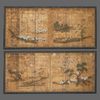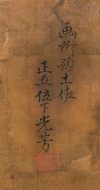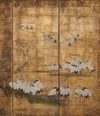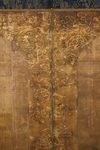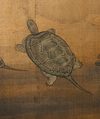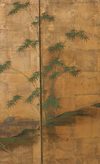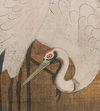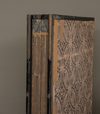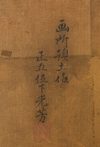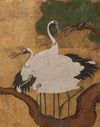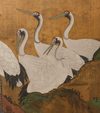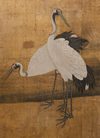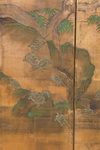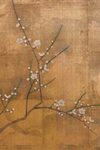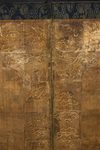Lot 126 PAIR OF 6-PANEL BYÔBU 屏風 (FOLDING SCREENS) BY TOSA MITSUYOSHI
An exquisite and rare pair of tall six-panel byôbu 屏風 (folding screens) by Tosa Mitsuyoshi 土佐光芳 (1700–1772), featuring the auspicious pairing of cranes 鶴 (tsuru) and long-tailed turtles 蓑亀 (minogame), set against a luminous gold-leaf ground overlaid with silk mesh and bearing a richly aged patina.
In Japanese symbolism, the crane and the minogame are traditionally paired to express longevity, wisdom, and good fortune. It is said: “Cranes live a thousand years, turtles live ten thousand.” The minogame—a turtle with a trailing cloak of seaweed—represents resilience and enduring wisdom, while the crane, known for its grace and loyalty, symbolizes good fortune and lasting happiness. Together, they form a powerful emblem of steadfastness and blessings, often seen in art and celebratory contexts such as weddings.
An unusual compositional feature is the use of swirling cloud cartouches in low relief that frame three of the six panels on each screen with respective scenes in each one of them.
One screen presents a grand gathering of 40 cranes wading through water or soaring in flight, set near a slanting Japanese apricot tree 梅 (ume) in bloom. In a second cartouche, 40 turtles are shown near the banks of a tranquil river, framed by pine 松 (matsu) on one bank and bamboo 竹 (take) on the other, together forming the classical theme of The Three Friends of Winter 歳寒三友 (Saikan Sanyû), a motif of resilience through adversity.
The second screen features, on the left cartouche, another group of 40 turtles, this time shown with ume and bamboo on opposite riverbanks, growing from rocky outcrops. On the opposite side, 26 cranes gather beneath a curving pine tree that rises from a dramatic rock formation.
Both screens are signed in the lower outer corners:
Official Painter of the Tosa School – Junior Fifth Rank, Mitsuyoshi” 画所預土佐 正五位下光芳 (Gasho yo Tosa Shôgoi no ge Mitsuyoshi)
Tosa Mitsuyoshi 土佐光芳 (1700–1772), also read Mitsufusa, was a distinguished painter of the Tosa school during the mid-Edo period. The son of Tosa Mitsusuke 土佐光祐 (or Mitsutaka 光高), he demonstrated remarkable artistic promise from an early age. Following the deaths of his father and grandfather Tosa Mitsunari 土佐光成 in 1710, Mitsuyoshi was appointed Head of the Court Painting Bureau 絵所預 (e-dokoro azukari) at only eleven years old. In 1738, he produced the ceremonial daijō-e byōbu 大嘗会屏風 for Emperor Sakuramachi 桜町天皇, continuing the imperial Yamato-e tradition. His Buddhist name was Jokaku 浄覚.
Period: Japan – Circa 1737–1739 (Edo period), during the time Mitsuyoshi held the rank of Shôgoi 正五位 before he advanced further in court title.
Rendered in natural pigments and ink on gold-leaf overlaid with silk mesh. The panels are bordered by two silk brocade bands: a narrow inner band in gold and a wide outer band in blue. Each screen is mounted within a black lacquered wooden frame fitted with protective metal corner fittings.
Dimensions:
Total width of both screens: 735.2 cm
Width of a single screen: 367.6 cm (2 x 62.6 cm, 4 x 60.6 cm)
Height: 169.8 cm
Considering their age, both screens are in a very good restored condition, with expected signs of wear. Some repapering to the reverse. Please refer to the photos for a detailed condition reference.


